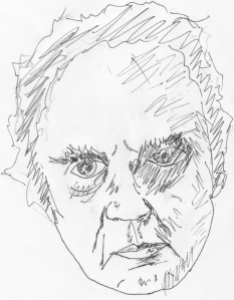BOOK | NON-FICTION | GRAPHIC NOVEL | HEALTH
OUR CANCER YEAR
by Harvey Pekar
RATING: ★ ★ ★ ★ ★

In addition to my practical experiences with hospitals and doctors and examinations and extremely long needles, I have also spent much time reading about the establishment, especially that aspect of it which relates to the treatments of leukemia and chronic graft versus host disease (cGVHD) of the lungs.
Most of my medical-related reading has been as research conducted on the internet.
Thank god for the internet. I am one of those annoying types who like to be knowledgeable just enough about something to make me, if not dangerous (which it just may), then certainly annoying.
I’ve come to find out over the past three years that doctors are a lot of fun to annoy.
While there are probably more books about cancer out there stalking, I mean, stocking the shelves than there are cancerous cells, I don’t recall ever reading any of them.
I don’t know why. Maybe because they all seemed too sanitary or too personal or too impersonal or too whiney or too who knows what.
I didn’t so I just left them all alone; that is, until I learned that the legendary Harvey Pekar had his own version of a cancer story to tell.
Pekar, who died recently, is famous for his graphic novel series AMERICAN SPLENDOR, in which he chronicles his life as a VA Hospital file clerk in Cleveland, Ohio. It doesn’t sound like much to work with — Cleveland, file clerk, VA Hospital — but somehow it has endured through the years and was even turned into a flick starring the always spot-on Paul Giamatti as Pekar.
In 1990, Pekar was diagnosed with and treated for Non-Hodgkins Lymphoma. Four years after surviving through that experience, he collaborated with his wife Joyce Brabner to publish an AMERICAN SPLENDOR-like graphic novel called OUR CANCER YEAR.
OUR CANCER YEAR is a gritty, honest and, sometimes, horrific portrayal of what life was like for Pekar and his wife while battling the disease.
But it is about more than just his experience with cancer. Pekar’s wife is also a comic book writer who focuses her work on peace projects. Through her efforts, we are provided side story glimpses about Operation Desert Shield and her work with teenage peace activists. And, because they had recently purchased a home at the time of his diagnosis, we also have the added stress that comes with buying a home on top of everything else that is happening to them.
I found the book interesting because Pekar really was able to bring out the hope and heartache and stress and pain that one, and one’s loved ones, must endure throughout the entire cancer experience, from first finding out about the disease, to all the damage that the chemotherapy treatment does to the body, to the overwhelming toll it takes on those closest to the cancer patient trying to care for him. It was also interesting to me to compare how he managed to cope with the disease versus how I tried to manage.
Let’s just say he is a glass half empty kind of guy. While I typically am too, I never felt as down about the disease as he apparently did.
While Pekar and I had many similar experiences battling our respective cancers, we also had many differences. One of the most significant differences was a painful experience that he had to go through that I never did (at least not yet–knock on wood). Pekar contracted Herpes Zoster, also known as shingles. For some reason, Shingles are a big threat to chemotherapy patients. Thankfully, my doctors were very aggressive about it and put me on an antiviral drug called Valtrex (Valaciclovir) as a preventative measure for at least a year, and which I will probably take for the rest of my life. Pekar also suffered much worse hallucinations and anxiety than I did as an effect from all the drugs cancer patients typically have to take.
While most of what you need to know about the medical establishment in general and cancer in particular can be found on the internet, some things can’t. In my perspective, if you really want to get telling insight into the hardships that come with having cancer you either need to experience it yourself first-hand, which I emphatically do not recommend, or you need to experience it in a less graphic but completely realistic and touching way, like reading Pekar’s graphic novel OUR CANCER YEAR.
~~~~

